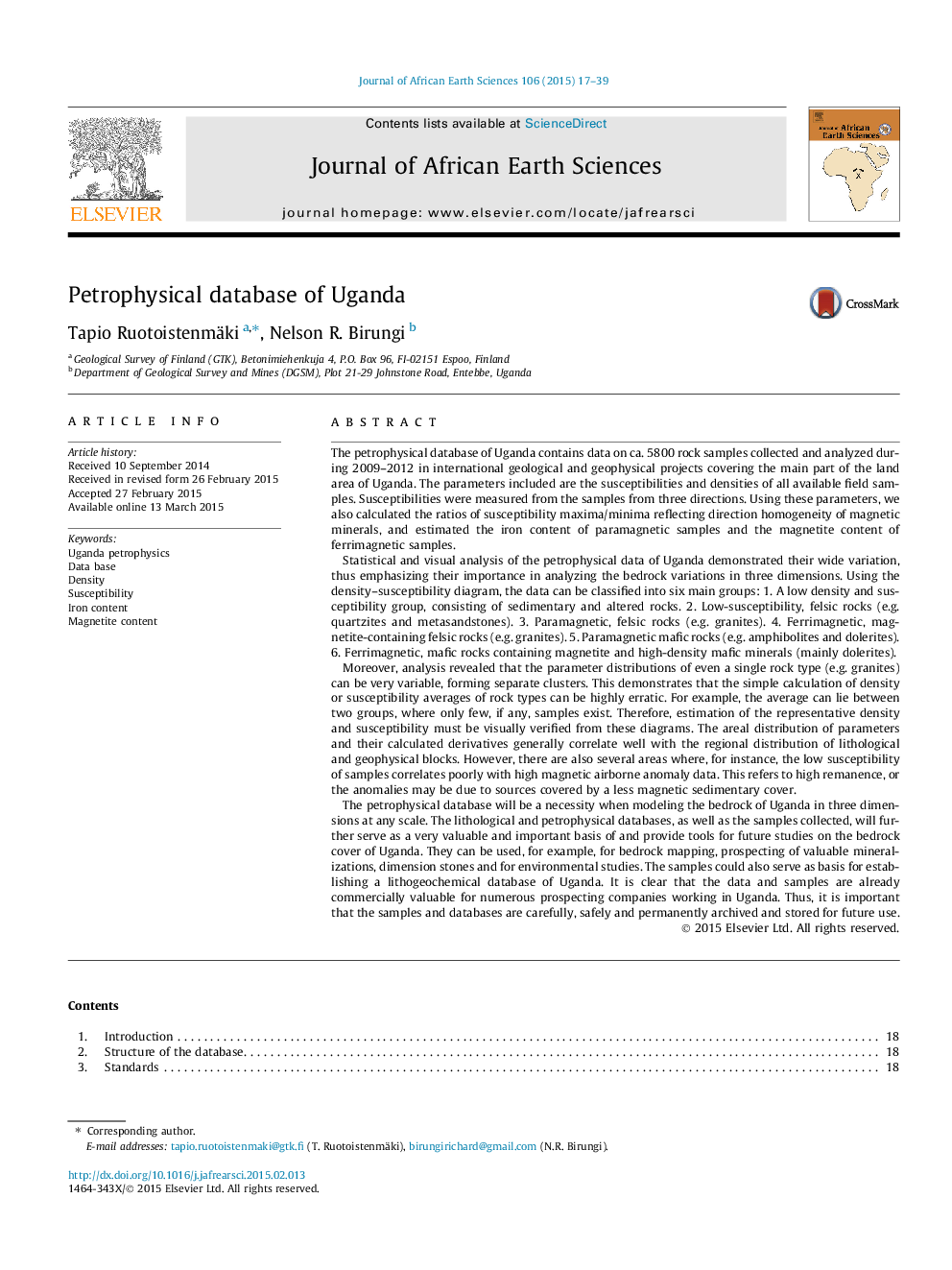| کد مقاله | کد نشریه | سال انتشار | مقاله انگلیسی | نسخه تمام متن |
|---|---|---|---|---|
| 4728520 | 1640201 | 2015 | 23 صفحه PDF | دانلود رایگان |
• Introducing probably the first national scale petrophysical database in Africa.
• Analysis of susceptibility and density values of ca. 5800 rock samples.
• Detailed diagrams and areal distributions of ten most common rock types.
• Variations of susceptibility directions and iron and magnetite contents of samples.
• Schematic density–susceptibility diagrams of 69 rock type classes.
The petrophysical database of Uganda contains data on ca. 5800 rock samples collected and analyzed during 2009–2012 in international geological and geophysical projects covering the main part of the land area of Uganda. The parameters included are the susceptibilities and densities of all available field samples. Susceptibilities were measured from the samples from three directions. Using these parameters, we also calculated the ratios of susceptibility maxima/minima reflecting direction homogeneity of magnetic minerals, and estimated the iron content of paramagnetic samples and the magnetite content of ferrimagnetic samples.Statistical and visual analysis of the petrophysical data of Uganda demonstrated their wide variation, thus emphasizing their importance in analyzing the bedrock variations in three dimensions. Using the density–susceptibility diagram, the data can be classified into six main groups: 1. A low density and susceptibility group, consisting of sedimentary and altered rocks. 2. Low-susceptibility, felsic rocks (e.g. quartzites and metasandstones). 3. Paramagnetic, felsic rocks (e.g. granites). 4. Ferrimagnetic, magnetite-containing felsic rocks (e.g. granites). 5. Paramagnetic mafic rocks (e.g. amphibolites and dolerites). 6. Ferrimagnetic, mafic rocks containing magnetite and high-density mafic minerals (mainly dolerites).Moreover, analysis revealed that the parameter distributions of even a single rock type (e.g. granites) can be very variable, forming separate clusters. This demonstrates that the simple calculation of density or susceptibility averages of rock types can be highly erratic. For example, the average can lie between two groups, where only few, if any, samples exist. Therefore, estimation of the representative density and susceptibility must be visually verified from these diagrams. The areal distribution of parameters and their calculated derivatives generally correlate well with the regional distribution of lithological and geophysical blocks. However, there are also several areas where, for instance, the low susceptibility of samples correlates poorly with high magnetic airborne anomaly data. This refers to high remanence, or the anomalies may be due to sources covered by a less magnetic sedimentary cover.The petrophysical database will be a necessity when modeling the bedrock of Uganda in three dimensions at any scale. The lithological and petrophysical databases, as well as the samples collected, will further serve as a very valuable and important basis of and provide tools for future studies on the bedrock cover of Uganda. They can be used, for example, for bedrock mapping, prospecting of valuable mineralizations, dimension stones and for environmental studies. The samples could also serve as basis for establishing a lithogeochemical database of Uganda. It is clear that the data and samples are already commercially valuable for numerous prospecting companies working in Uganda. Thus, it is important that the samples and databases are carefully, safely and permanently archived and stored for future use.
Figure optionsDownload as PowerPoint slide
Journal: Journal of African Earth Sciences - Volume 106, June 2015, Pages 17–39
